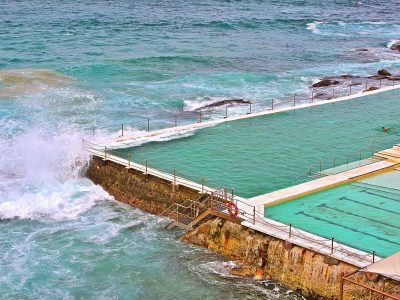Ocean Pools
My family this Christmas were kind enough to give me a copy of “Ocean Pools”, a lovely collection of photos and stories of 75 pools in Australia. The authors are Chris Chen (photographer) and Marie-Louise McDermott (sports historian and Chairperson of All Into Ocean Pools Inc.) The book is published by Thames&Hudson.
Helen Pitt, a swimmer and journalist, has written a foreword entitled “Sacred Places” capturing the spirit and personal tone of the book: “Ocean pools are my happy place. When I think of them, I smile. Being near them is good for my mental and emotional health. I learnt this after my husband William’s death, the sea was a tonic and a comfort”.
It is also very personal to me. The front cover is a view of the northeast corner on Bondi Baths. My grandfather, William Cowie, one of the early members of Bondi Icebergs, took me in his arms down the steps shown in the photo onto the rock platform. Waves were gently breaking over the drop-off just outside the pool; it was the summer of 1943, and it was fun until my mother appeared. Grandpa had “escaped” with me while she was in the change room. My next recollection was her standing on the top of those steps screaming at him to get back to the safety of the pool. She was familiar with the site as a former member of the ladies’ swim team. Memories of the pool continue as a few years later I was taught to swim in the children’s pool at these baths shown on page 126. It was also where I did lifesaving classes at school in 1952; many years later I witnessed our daughter Jeanette participate in an inter-varsity water polo competition as waves washed over the pool wall.
The book will evoke stories for many. It will also help us understand the history of their use (summarised on pages 12 and 14). All but five are from locations in NSW (1 in QLD, 1 in Vic., and 3 in WA). This reflects the prevalence of rock platforms carved in headlands along this coast providing “humble-yet-treasured saltwater sanctuaries for humans and marine life, places considered the beating heart of many coastal communities”. Water temperatures and wave overwash generally facilitate clean and warm conditions making the pools “restorative environments, combining a sense of refuge with expansive views”.
For over 15 years I have conducted a summer field excursion for Randwick Council around Coogee. This area has four pools each with its distinctive history (Giles Baths; Ross Jones Memorial Pool; McIver’s Ladies Baths; and Wylie’s Baths; see pages 144-163). It is a privilege to tell stories of these pools and each year I learn something new to say. This book informed me of the role of the Commonwealth Government in funding the 1947 construction Ross Jones Pool sited just below the Coogee Lifesaving Club building. It was seen as “compensation” for damage to Coogee Beach during World War 11. Legal history exists for the Ladies Baths; after a male challenge it was found it could operate under an exemption from the NSW anti-discrimination law. Helen Pitt describes swimming here as being in a “sacred female space”.
The book beautifully illustrates various settings for each pool showing the geology of surrounds. There are different types of pool (some more “natural” than others), and information is provided on conditions of access, degree of supervision, and extent to which a pool may be “lap-friendly”. They are seen as important to our future “As Australia’s population rises and urban sprawl continues to grow, ocean pools become more significant for people keen to immerse themselves in nature”; the authors then add with some alarm after noting climate change: “They will continue to delight and offer valued protection against rips, surf and sharks”!
Additional note: Angus Gordon has provided me with an extended abstract of a paper recently presented at the 37th International Conference Coastal Engineering (Sydney, 4-9/12/22). He is a co-author along with James Carley, Ron Cox and Nicole Larkin on “Ancient and contemporary coastal engineering structures unique to Australia” (James is the lead author: james.carley@unsw.edu.au).
Ocean pools are one of the coastal structures discussed in this paper. They refer to the approximately 60 pools in NSW and are often renovated at intervals of 10 to 20 years. Most pools are managed by local councils. Heavily used pools are regularly drained at low tide (often at night) and then refilled using fixed or movable pumps to manage water quality. Cost of maintenance for such pools can be as much as $150k per year. In order to improve flushing the authors note that “some councils have reconfigured some ocean pools by lowering the seaward edge, thereby increasing the quantity and frequency of overwash”. However, this can add to the hazard of swimming in pools during periods of overwash as well as permit more influx of sand and wrack requiring cleaning; they state that contemporary design should seek a balance between overwash flushing supplemented with flushing using a pump.
Bruce Thom
Words by Prof Bruce Thom. Please respect the author’s thoughts and reference appropriately: (c) ACS, 2023. For correspondence about this blog post please email admin@australiancoastalsociety.org.au
#231



 Protecting Nature: Art of the Impossible?
Protecting Nature: Art of the Impossible?